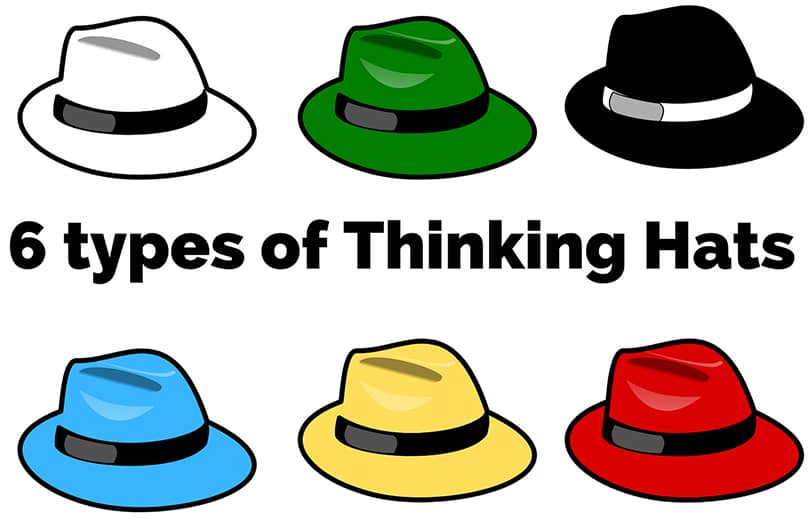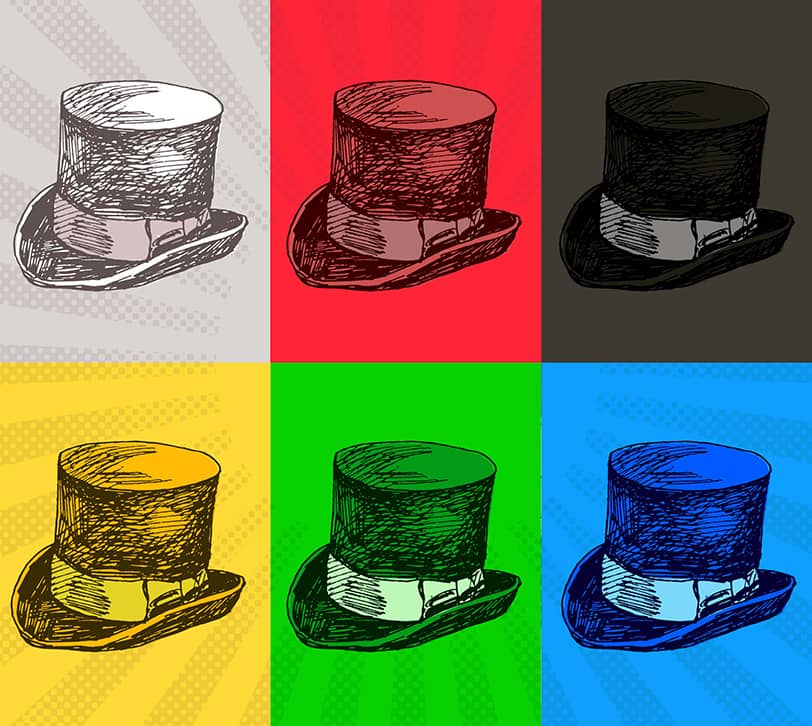Imagine the following situation: there’s a heated debate in your team about a new project. Some are shouting, “It’s too risky!” Others passionately argue, “But it’s profitable!” Skeptics demand hard numbers, while some just have a gut feeling that “something’s off.” The result? Chaos, conflicts, and zero progress. It’s precisely for such scenarios that Edward de Bono, the British psychologist and guru of creative thinking, developed the Six Thinking Hats method – a simple yet powerful tool that replaces useless arguments with structured dialogue.
The essence of the method is to divide thinking into six modes, each represented by a differently colored hat. Instead of chaotically jumping from emotions to facts, from criticism to ideas, you take turns “wearing” the hats: analyzing data (white), listening to intuition (red), identifying risks (black), highlighting benefits (yellow), generating unconventional solutions (green), and finally, managing the process (blue). This isn’t just a technique—it’s a language that teaches conscious thinking.
Edward de Bono, the author of 85 books and an advisor to global corporations, realized back in the 1980s that traditional thinking, built on arguments and linear logic, often leads to dead ends. His method was a breakthrough because it replaced confrontation with collaboration. For example, companies like IBM and British Airways use it to avoid endless meetings, while schools teach children to think flexibly.
A striking example: A startup team argued for weeks about launching a product. Marketers insisted on bold design, finance specialists warned about budget constraints, and developers pushed back on deadlines. By applying the Six Thinking Hats, they broke down the problem in just an hour: gathered data, addressed fears, found a compromise, and even came up with a non-obvious solution—to release a “simplified” version for testing. The result? The project launched on time, and conflicts turned into constructive outcomes.
This method isn’t just theory. It’s the key to turning any heated discussion into a creative process. And now, as the world has grown more complex and decisions require a multifaceted approach, it’s more relevant than ever.

History of the Method: How the “Six Hats” Idea Was Born
We all think differently: some rely on logic, others on emotions, while some only see problems. But what if we could consciously switch between these thinking modes? That’s exactly the question Edward de Bono asked himself when creating his famous method.
The idea of the Six Hats didn’t appear by chance. Observing how people argue, make decisions, and hit dead ends, de Bono realized the main problem: chaotic thinking. We mix facts with emotions, criticism with ideas, and end up with a jumble of arguments. A simple way to structure this process was needed. Thus, the metaphor of hats was born—after all, a hat can be easily put on and taken off, just like the role you choose for your thinking.
Brief Biography of Edward de Bono
Edward de Bono (1933–2021) was a British psychologist, physician, and philosopher, often called the father of lateral (out-of-the-box) thinking. Born in Malta, he studied medicine at Oxford and psychology at Cambridge. He was always fascinated by how the human mind works and why people think in patterns.
De Bono wasn’t just a theorist—he tested his ideas in practice. Working with business leaders, teachers, and even politicians, he saw how traditional thinking hindered progress. His books, such as Six Thinking Hats and Lateral Thinking, became bestsellers, and his methods were adopted by corporations like IBM, Shell, and Nokia.
Why Did He Create This Method?
De Bono noticed that in arguments, people often take a fixed position and defend it to the end. For example, a pessimist sees only risks, an optimist only benefits, and an analyst demands data. As a result, discussions turn into ego battles rather than truth-seeking.
He had an idea: what if thinking were divided into clear modes? So that instead of arguing, a person could say, “Now I’ll put on the black hat and list all the risks. Then the yellow one—and find the advantages.” This approach eliminates conflict because criticism stops being a personal attack—it’s just a “role” that can be switched.
Criticism of Traditional Thinking and the Need for a New Approach
De Bono criticized Western thinking styles, which he called “Socratic”—based on debate, refutation, and the search for a single correct answer. In his view, this was an outdated model:
- It’s slow—while parties prove their point, time runs out.
- It’s destructive—arguments don’t produce truth, just one side’s victory over another.
- It stifles creativity—criticism kills new ideas at the root.
The Six Thinking Hats method was his answer to these problems. Instead of arguments—constructive dialogue. Instead of chaos—order. Instead of one-sided solutions—a multi-perspective approach. That’s why it’s been embraced in business, education, and even politics.
Fun fact: De Bono joked that if governments used this method, many wars could be avoided—because the “red hat” (emotions) would quickly reveal that conflicts are often based on anger, not logic.
Thus, the Six Thinking Hats isn’t just a technique—it’s a philosophy of thinking that teaches us to break free from habitual patterns. And as practice has shown, it works.

The Essence of the Method: How Do the Six Hats Work?
Imagine your thinking is like an orchestra. The drums are emotions, the violins are logic, the trumpets are creativity. If everyone plays at once, it’s just noise. But if each instrument plays in turn—harmony emerges. The Six Thinking Hats method works the same way: it helps you “activate” different thinking modes one by one, making discussions clear, productive, and even engaging.
Why hats? In life, we often “switch hats”: at work, we think rationally; with friends, emotionally; in a crisis, critically. De Bono simply made this process conscious. Each hat is a clear role you can try on—and just as easily take off. This isn’t just convenient—it eases tension, because now you’re not arguing, but exploring a problem together from different angles.
Explanation of Each “Hat”
- White Hat — Facts and Data
When you wear the white hat, you become an objective observer. Your task is to work only with verified information: numbers, statistics, documents. No interpretations or assumptions! Example questions:- What data do we have?
- Which facts are confirmed, and which aren’t?
- What don’t we know, and do we need to find out?
Example: A team discusses launching a new product. In white hat mode, they state: “Market demand is 15%, competitors offer similar products for $100.”
- Red Hat — Emotions and Intuition
Here, everything usually kept hidden is allowed: fear, excitement, gut feelings, even biases. No explanations needed—just voice your feelings honestly. This helps uncover hidden motives. Questions:- How do I feel about this idea?
- What’s my first reaction (even if irrational)?
- Is there an “inner voice” suggesting something?
Example: “I feel customers won’t understand this design” or “I’m thrilled by this concept, though I can’t explain why.”
- Black Hat — Criticism and Risks
This is the caution mode. You look for weak spots, potential threats, and reasons things might go wrong. Key: this isn’t “negativity,” but necessary analysis. Questions:- What could go wrong?
- Where are we miscalculating?
- What failed in similar projects?
Example: “If we lower the price, profits will drop by 20%” or “Regulations might change and ban our product.”
- Yellow Hat — Optimism and Benefits
The opposite of the black hat. You focus on opportunities, advantages, and positive scenarios. Even if an idea seems doubtful, try finding its upsides. Questions:- What benefits are we overlooking?
- What if things go better than expected?
- Are there hidden opportunities?
Example: “This risky marketing move could attract media attention” or “Even if sales are low, we’ll gain loyal customers.”
- Green Hat — Creativity and New Ideas
The “brainstorming” mode—no bad suggestions allowed. The goal is to think outside the box and find unconventional solutions. Use lateral thinking techniques:- What if we did the opposite?
- How would a child solve this?
- What crazy ideas haven’t we considered?
Example: “Instead of discounts, let’s offer exclusive content” or “What if our product isn’t sold but rented?”
- Blue Hat — Process Control
The “conductor’s hat.” The wearer (usually a moderator) ensures rules are followed:- Which hats have we used?
- Is it time to switch modes?
- Do we need to dive deeper into a role?
Example: “We’ve criticized too long—let’s switch to the yellow hat and find positives” or “Before deciding, let’s revisit the white hat and verify data.”
Why Hats? (The Role-Switching Metaphor)
De Bono didn’t choose hats randomly. Here’s why the metaphor works:
- Visual clarity. Colors associate with emotions (red = passion, black = caution), making it easy to remember.
- Playfulness. “Wearing” a hat turns serious discussion into almost theatrical action, easing tension.
- Flexibility. A hat can be removed—teaching people not to fixate on one role.
Key nuance: The method doesn’t require actual hats (though they can be used for clarity). The main thing is agreeing on rules. For example, a team might say: “Now, we all wear green hats”—and spend 10 minutes generating ideas without criticism.
The six hats are an “instruction manual” for your thinking. Like paints on a palette, they let you “paint” solutions consciously, preventing chaos in discussions. And as practice shows, it’s one of the few methods equally effective in a school classroom and a corporate boardroom.

How to Apply the Method in Practice?
The theory of the Six Thinking Hats seems simple, but the real magic happens when the method is applied to real-life situations. Here’s how it often goes: a team gathers to discuss an important issue, but instead of solutions, they get endless arguments, fatigue, and a sense of wasted time. De Bono’s method breaks this pattern, turning chaotic discussions into a clear, productive process.
The key to success is discipline. You can’t just say, “Let’s think in different hats.” You need structure, timing, and clear rules. The good news? Anyone can master this—from schoolchildren to top executives. Let’s break it down step by step and then look at a real-world example.
Step-by-Step Guide
a) Define the Problem or Task
Before starting, phrase the question as concretely as possible.
- Bad example: “How can we improve sales?”
- Good example: “How can we increase website conversion from 2% to 4% within a quarter?”
Tip: Write the problem on a board or in a chat so everyone can see it.
b) Sequentially “Wear” the Hats
There are two approaches:
- Strict order (e.g., white → red → black → yellow → green → blue).
- Flexible order (the blue hat chooses the sequence based on the situation).
Recommendations:
- Start with the white hat (facts)—this creates a common knowledge base.
- Use the red hat (emotions) carefully: 2–3 minutes, no debates.
- Pair the black and yellow hats to balance risks and opportunities.
- Set aside a separate time block (5–10 min) for the green hat (creativity).
Important: Limit time for each hat (e.g., 5 minutes). Use a timer.
c) Record Ideas for Each Role
Assign a “secretary” or use a shared board (Miro, Google Docs). Format:
| Hat | Ideas |
|---|---|
| White | Data: Conversion rate is 2%, 60% of users drop off at step 3 |
| Red | “I find our checkout process frustrating” |
| Black | If we simplify the form, spam submissions might increase |
d) Analyze the Results
Once all hats have been “worn,” the blue hat (moderator) summarizes:
- What key ideas/risks were identified?
- Is additional data needed?
- Which solutions seem most promising?
Lifehack: Try the “hat filter” – run the best ideas through white/black/yellow modes for validation.
Example of Use
Situation: A startup is developing a new fitness tracker. The team debates the key feature.
Process:
- White Hat:
- “70% of our users are women aged 25–35.”
- “Competitors offer calorie tracking but don’t account for menstrual cycles.”
- Red Hat:
- “I worry that focusing on women’s health will alienate male users.”
- “I love the idea but lack confidence in the technical execution.”
- Black Hat:
- “Cycle analysis will require complex algorithms and FDA approvals.”
- “This could extend development by 3 months.”
- Yellow Hat:
- “We’ll dominate a niche with almost no competition.”
- “Could gain media attention as an innovative product.”
- Green Hat:
- “What if we add ‘male’ and ‘female’ modes in one tracker?”
- “Instead of cycle tracking, offer general hormone-based tips.”
- Blue Hat:
Outcome: “We choose a hybrid approach. Start with a basic version (general recommendations) while testing demand for advanced analytics.”
Result: In 30 minutes, the team turned a conflict into an action plan, avoiding both hasty decisions and analysis paralysis.
Why Does It Work?
- Time-saving: No tug-of-war—each aspect is discussed systematically.
- Engagement: Introverts and creatives get equal opportunities.
- Flexibility: Adaptable to any task.
Try it in your next discussion—you’ll be surprised how much easier it is to find solutions when thinking becomes a game with clear rules.

Why Did the “Six Thinking Hats” Method Change the World?
In a world where decision-making speed often outweighs quality, and creative thinking is stifled by rigid corporate frameworks, the Six Thinking Hats method became a breath of fresh air. It doesn’t just offer another way to generate ideas—it transforms the very culture of thinking, turning chaotic arguments into meaningful dialogues.
What makes it truly revolutionary? Unlike traditional approaches that fixate on clashing opinions (“I’m right—you’re wrong”), de Bono’s method teaches parallel thinking. It’s as if, instead of arguing whether the front or rear wheels of a car are more important, people started collaboratively designing the entire vehicle.
Where Is It Applied?
Business
- Strategy sessions: Companies use the hats for market analysis, product launches, and crisis management.
- Negotiations: Helps separate emotions from facts to find win-win solutions.
- Project management: Risk assessment (black) and opportunity evaluation (yellow) before kickoff.
Education
- Taught as a mandatory skill in schools across the UK and Australia.
- Universities apply it for group work: students learn to discuss constructively, not argue.
Science
Research teams use it for:
- White hat: Data analysis
- Green hat: Hypothesis generation
- Black hat: Identifying flaws in theories
Personal Development
Making tough decisions (e.g., career change):
- White: What resources do I have?
- Red: How do I feel about this move?
- Black: What could go wrong?
Success Stories
- IBM: Cut strategic meeting times by 75% using a strict hat sequence.
- British Airways: Redesigned baggage handling with the method, reducing losses by 30%.
- PepsiCo: Uses green hats for flavor creativity + black hats for feasibility checks.
- NASA: Prevents groupthink in engineering teams during mission risk assessments.
Nokia Case: In the 2000s, black-hat thinking (“Risks are too high”) dominated smartphone discussions. When they adopted the method systematically in the 2010s, they re-entered the market with innovative solutions.
How Is It Better Than Traditional Brainstorming?
| Criterion | Brainstorming | Six Thinking Hats |
|---|---|---|
| Structure | Chaotic idea flow | Clear thinking phases |
| Criticism | Banned | Allocated (black hat) |
| Emotions | Ignored | Addressed (red hat) |
| Outcome | Many ideas, little analysis | Balanced decisions |
Key Advantages
- Eliminates conflict: When someone says “This is risky” in black-hat mode, it’s seen as a process step, not a personal attack.
- Saves time: Deutsche Bank reduced decision-making from 3 hours to 45 minutes post-implementation.
- Unlocks team potential: Introverts participate more actively with clear rules.
De Bono proved that thinking is a skill—one that can be developed. His method bridged the analytical West and holistic East, showing that solving complex problems requires not choosing between logic and creativity, but wielding both together.
Today, as the world faces challenges that defy linear thinking, the Six Thinking Hats isn’t just a tool—it’s the essential language of future communication. As one Google executive put it: “It’s like a Swiss Army knife for thinking—always good to have on hand.”

Criticism and Limitations of the Method
Edward de Bono’s Six Thinking Hats method, for all its effectiveness, is not a magic wand that solves all problems. Like any tool, it has its limits and can fail if used incorrectly or in the wrong context.
Some critics call the method too mechanistic, arguing that it “boxes” fluid thinking into rigid frameworks. Others note that without an experienced moderator, the process can become a mere formality. So where do the pitfalls lie, and in what situations might other approaches be better?
When Might It Not Work?
A) Highly Emotional Situations
If a team is already in acute conflict (e.g., personal animosity or power struggles), the method may not help. The red hat (emotions) could escalate tensions, and participants may struggle to switch to rational modes.
Example: Trying to use the method during a business split between feuding partners.
B) Tight Time Constraints
The method requires time for sequential discussion. If a decision is needed in 5 minutes (e.g., in a crisis), the hats will only slow things down.
C) Lack of Data
The white hat (facts) is useless if information is missing or unreliable. For example, a startup entering a completely new market can’t rely on statistics.
D) Routine Tasks
For simple, repetitive decisions (e.g., “which printer to buy for the office”), the method is excessive. A classic “pros and cons” list suffices.
E) Cultural Differences
In some cultures (especially hierarchical ones), subordinates may hesitate to openly express opinions under the red or black hats in front of superiors.
Common Mistakes in Application
Mistake 1: Confusing the Sequence
- Wrong: Starting with the red hat (emotions)—this can set a negative tone immediately.
- Right: Begin with the white hat (facts) to establish a common baseline.
Mistake 2: Uneven Time Distribution
- Problem: Getting stuck in the black hat (criticism) kills creativity.
- Solution: Strictly limit time for each hat (e.g., 5 minutes per mode).
Mistake 3: Neglecting the Blue Hat
- Consequence: Without a moderator, discussions descend into chaos.
- Fix: Assign someone to manage the process.
Mistake 4: Superficial Use
- Example: Participants mechanically list ideas without embracing the role.
- Correction: Remind them that a hat isn’t just a color—it’s a shift in thinking.
Mistake 5: Mixing Hats
- Typical Scenario: In white hat mode, someone says, “I feel this data is inaccurate” (this is already red or black hat).
- Solution: The moderator gently steers the group back on track.
Alternative Thinking Methods (for Comparison)
| Method | Pros | Cons | When to Choose Instead of Hats? |
|---|---|---|---|
| Brainstorming | Generates ideas quickly | Lacks risk analysis | Need many ideas in a short time |
| SCAMPER | Systematic innovation approach | Requires training | Need to improve an existing product |
| Decision Tree | Visually maps options | Doesn’t foster creativity | When clear alternatives exist |
| 5 Whys | Targets root causes | Linear, no creativity | For analyzing errors and failures |
| Delphi Method | Minimizes group pressure | Time-consuming | Need expert consensus |
Choosing the right method depends on the task:
- For quick decisions, brainstorming works better.
- For deep problem analysis, use a decision tree.
- For innovation, try SCAMPER.
- The Six Hats excel when you need a balanced view (creativity + analysis + emotions).
De Bono’s method isn’t a universal solution but a powerful tool for structured, multifaceted thinking. It belongs in your toolkit—but don’t treat it as a cure-all.
Tip: Combine it with other approaches. For example, start with the Six Hats for analysis, then apply SCAMPER to refine ideas.

Conclusion
Unlike outdated approaches where truth emerges through arguments, the Six Thinking Hats method offers something revolutionary: the ability to explore any topic from all angles—not through destruction, but through creation. It has remained relevant for decades because it addresses the key challenge of our time: how to stay flexible in rigid environments. Companies value it for cutting endless meetings short, educators for developing students’ critical thinking, and ordinary people for its simple decision-making algorithm that reduces stress.
But theory is meaningless without practice. Why not try “wearing” the hats today? Start small: use this framework for your next everyday decision—from buying new appliances to planning a vacation. At work, suggest colleagues discuss a current project using the hats—you’ll be surprised how much easier it makes finding solutions. The key is to remember the method doesn’t require perfect execution on the first try. Even if it feels awkward initially, the mere habit of separating emotions, facts, and creativity will improve your thinking for the better.




